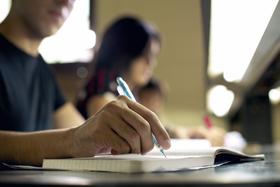Soldan International Studies High School is a public magnet high school in the Academy neighborhood of St. Louis, Missouri, United States, that is part of St. Louis Public Schools. Soldan was known for its wealthy and predominantly Jewish student population, from its opening in 1909.
Serving 395 students in grades 9-12, Soldan International Studies ranks in the bottom 50% of all schools in Missouri for overall test scores (math proficiency is bottom 50%, and reading proficiency is bottom 50%).
The percentage of students achieving proficiency in math is ≤5% (which is lower than the Missouri state average of 40%). The percentage of students achieving proficiency in reading/language arts is 15-19% (which is lower than the Missouri state average of 43%).
The student-teacher ratio of 12:1 is equal to the Missouri state level of 12:1.
Minority enrollment is 98% of the student body (majority Black), which is higher than the Missouri state average of 32% (majority Black).
Quick Facts (2025-26)
- School Type: Magnet School
- Grades: 9-12
- Enrollment: 395 students
- Student-Teacher Ratio: 12:1
- Minority Enrollment: 98%
- Graduation Rate: 75-79% (Btm 50% in MO)
- Overall Testing Rank: Bottom 50%
- Math Proficiency: ≤5% (Btm 50%)
- Reading Proficiency: 15-19% (Btm 50%)
- Science Proficiency: ≤5% (Btm 50%)
- Source: National Center for Education Statistics (NCES), MO Dept. of Education
Top Rankings
Soldan International Studies ranks among the top 20% of public schools in Missouri for:
Category
Attribute
Percent Eligible For Free Lunch
School Overview
Soldan International Studies's student population of 395 students has declined by 25% over five school years.
The teacher population of 34 teachers has declined by 15% over five school years.
School Type
Grades Offered
Grades 9-12
(No virtual instruction)
(No virtual instruction)
Total Students
395 students
Gender %
Total Classroom Teachers
34 teachers
Year Founded
1909
Colors
Maroon, Gold
School Calendar
School Rankings
Soldan International Studies ranks within the bottom 50% of all 2,076 schools in Missouri (based off of combined math and reading proficiency testing data).
The diversity score of Soldan International Studies is 0.17, which is less than the diversity score at state average of 0.51. The school's diversity has stayed relatively flat over five school years.
Overall Testing Rank
#1995 out of 2076 schools
(Bottom 50%)
(Bottom 50%)
Math Test Scores (% Proficient)
≤5%
40%
Reading/Language Arts Test Scores (% Proficient)
15-19%
43%
Science Test Scores (% Proficient)
≤5%
38%
Student-Teacher Ratio
12:1
12:1
American Indian
n/a
n/a
Asian
1%
2%
Hispanic
6%
8%
Black
91%
15%
White
2%
68%
Hawaiian
n/a
1%
Two or more races
n/a
6%
All Ethnic Groups
Graduation Rate
75-79%
90%
Eligible for Free Lunch
100%
42%
Eligible for Reduced Lunch (13-14)
7%
7%
School Statewide Testing
School District Name
Source: National Center for Education Statistics (NCES), MO Dept. of Education
School Notes
- School Mascot: Dragons
Profile last updated: 02/09/2025
Frequently Asked Questions
What is Soldan International Studies's ranking?
Soldan International Studies is ranked #1995 out of 2,076 schools, which ranks it among the bottom 50% of public schools in Missouri.
What schools are Soldan International Studies often compared to?
Soldan International Studiesis often viewed alongside schools like Gateway High School by visitors of our site.
What percent of students have achieved state testing proficiency in math and reading?
≤5% of students have achieved math proficiency (compared to the 40% MO state average), while 15-19% of students have achieved reading proficiency (compared to the 43% MO state average).
What is the graduation rate of Soldan International Studies?
The graduation rate of Soldan International Studies is 75-79%, which is lower than the Missouri state average of 90%.
How many students attend Soldan International Studies?
395 students attend Soldan International Studies.
What is the racial composition of the student body?
91% of Soldan International Studies students are Black, 6% of students are Hispanic, 2% of students are White, and 1% of students are Asian.
What is the student-teacher ratio of Soldan International Studies?
Soldan International Studies has a student ration of 12:1, which is equal to the Missouri state average of 12:1.
What grades does Soldan International Studies offer ?
Soldan International Studies offers enrollment in grades 9-12 (No virtual instruction).
What school district is Soldan International Studies part of?
Soldan International Studies is part of St. Louis City School District.
In what neighborhood is Soldan International Studies located?
Soldan International Studies is located in the Academy And Sherman Park neighborhood of Saint Louis, MO.
School Reviews
5 10/10/2025
I would like to go to soldan because its a good highschool to start at
Review Soldan International Studies. Reviews should be a few sentences in length. Please include any comments on:
- Quality of academic programs, teachers, and facilities
- Availability of music, art, sports and other extracurricular activities
Recent Articles

School Vouchers: Updated Pros and Cons (2025 Review)
Comprehensive 2025 analysis of school vouchers, weighing benefits and challenges for families, funding, outcomes, and policy directions.

Benefits and Drawbacks of Homework in 2025
Explore updated 2025 insights on homework鈥檚 benefits, drawbacks, mental health impact, best practices, and policy trends in U.S. public schools.

Charter Schools vs Public Schools 2025: Key Differences & Trends
Explore updated 2025 insights comparing charter schools vs public schools, enrollment, academic outcomes, funding, and real-world examples for families and educators.





